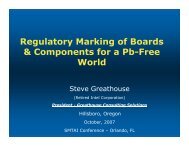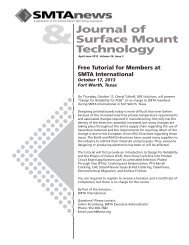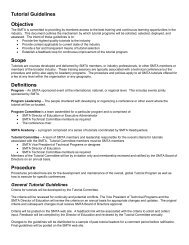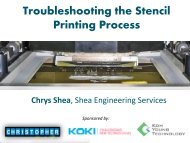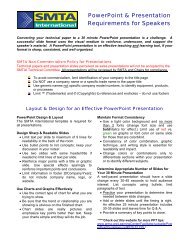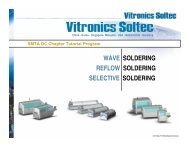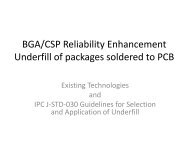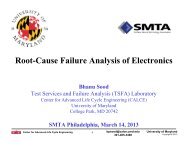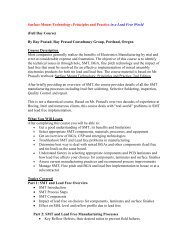Nickel/Palladium Surface Finish, Semiconductor Packaging - SMTA
Nickel/Palladium Surface Finish, Semiconductor Packaging - SMTA
Nickel/Palladium Surface Finish, Semiconductor Packaging - SMTA
- No tags were found...
You also want an ePaper? Increase the reach of your titles
YUMPU automatically turns print PDFs into web optimized ePapers that Google loves.
NICKEL / PALLADIUM SURFACE FINISH FOR SEMICONDUCTORPACKAGING APPLICATIONSC. FAN, A. BLAIR AND J. A. ABYSLUCENT TECHNOLOGIES, ELECTROPLATING CHEMICALS & SERVICESSTATEN ISLAND, NEW YORKAbstractTo meet increasingly strengthened environmental and legislative requirements for lead-free finishes, the electronics industryhas renewed interests in nickel / palladium plated leadframes in semiconductor packaging. Over the last few years, newsurface finishing processes have been developed to improve the performance of leadframes in soldering, wirebonding andother packaging aspects. Meanwhile, the hesitation to convert traditional leadframe finishing processes (selective silverplating and post tin-lead plating) to nickel / palladium finishing has persisted in this cost-sensitive industry due to theinconsistency of palladium supply and price issues. In this paper we will introduce background information of the Pd PPF(palladium pre-plated frames) technology, review the new technical and economic developments in leadframe surfacefinishing and provide comments and discussion.Keywords: <strong>Nickel</strong>/<strong>Palladium</strong> <strong>Surface</strong> <strong>Finish</strong>, <strong>Semiconductor</strong> <strong>Packaging</strong>, Leadframe, Solderability, WirebondingINTRODUCTIONApplication of palladium surface finishing tosemiconductor leadframe prior to packaging was firstreported in mid 1980s. 1-3 Since then the Pd PPF(palladium pre-plated frame) technology has beenincreasingly accepted and employed in the industry toreplace the traditional leadframe surface finishing, i.e.selective silver plating on the die attach and wirebondingareas and tin-lead solder post-plating on the outer leadsafter the packaging. 4-6 Compared with the traditionalfinishing, the Pd PPF technology utilizes high speed nickeland palladium plating on entire leadframe surface (Figure1), improves the plating process and the quality of theplated leadframes, and reduces environmental concernsand overall packaging cost. The substantial advantages ofusing the Pd PPF finishing can be listed as follows.• Plating process improvements◊ Elimination of selective plating◊ Completion of all wet processes prior topacking◊ Increase in throughput and production yields• Quality improvements◊ Improvement and maintenance of coplanarity◊ Reduction of solder bridging◊ Elimination of silver migration• Environmental Improvements◊ Elimination of cyanide from plating◊ Elimination of lead from plating• Overall packaging cost reduction◊ Simplification of plating operation◊ Elimination of post-plating◊ Reduction of waste treatment◊ Extension of shelf-life of leadframesBecause of the advantages in the technical andenvironmental issues, more platers and leadframe packageend users are willing to use the Pd PPF technology in thepackaging operation. However, the hesitation exists due tothe uncertain supply and the significant price increase ofpalladium raw material over the last two years.Traditional TechnologyPd PPF TechnologyIC DiePost-Plated SolderIC DieNi/Pd Plated on Entire <strong>Surface</strong>Selectively Plated AgFigure 1. Schematic cross-sections of the leadframesplated with silver and solder or nickel / palladium,after die attach, wirebonding and encapsulation andbefore trimming and forming.Recent development of strengthening environmentalprotection and legislative requirement of using lead-freematerials in the electronics industry have become anurgent issue. 7 Lead will be banned to use in a few years atleast in developed countries. Legislation aimed ateliminating the use of lead in electronic devices isgenerating tremendous pressure on the industry. EngineersPdNi
are making considerable effort to search for alternativematerials to tin-lead solders and finishes.In semiconductor leadframe packaging, the tin-lead postplatingwill disappear soon and be undoubtedly replacedby environmentally friendly finishing processes. Anysuccessful substitute for tin-lead finish must have thefollowing attributes:• Be lead-free• Be environmentally friendly and meet testrequirements• Be electrically conductive• Be solderable• Be reasonably corrosion resistant• Be ductile and have sufficient mechanical strength• Be compatible with other solder finishes• Be reasonably abundant, hence relatively inexpensive• Be produced from an easily controlled processAt present, it seems that pure tin and some other tin alloys,such as tin-copper, tin-bismuth, tin-silver, tin-nickel, tinzincand some tertiary alloys, are the only replacementcandidates available in electroplating for tin-lead.However, most of these tin alloy finishes and the processesto plate them fail to satisfy one or more of the aboverequirements. Electrodeposits of pure tin are capable ofmeeting all the necessary requirements for successfulsubstitution for tin-lead. There is, however, concern aboutpotential whisker formation on pure tin deposits. 8 Thewhiskers generated during and/or after plating, with alength from a few micrometers to several millimeters, maycause shorts in electronic devices, particularly, in finepitchhigh I/O (input/output) components. Modern platingprocesses have been reported 9 which do much to allay thisfear. In this regard, we have undertaken an extensivestudy on this phenomenon. In spite of this potential, puretin remains an interesting and potentially successfulsubstitute for tin-lead provided that the correct process isemployed using appropriate controls.While the industry is in search of ideal tin and tin alloyfinishing processes, the industry has renewed the interestsin the application of the Pd PPF technology. Despite theobvious economic disadvantage of palladium, thisleadframe finish is well established. Any special assemblyconditions required to accommodate this finish are alreadywell known. <strong>Nickel</strong>/palladium should not be dismissedsimply because of higher raw material costs. There areconsiderable cost savings to be factored when assessingthe overall cost of IC (integrated circuit) packaging.Higher production speed, higher yields, less waste andlower disposal costs all contribute to reducing the total costimpact of converting to nickel/palladium PPF.In the Pd PPF technology, a thin palladium layer with atypical thickness ranging from 0.075 to 0.175 µm (3-7 µin)is usually applied over a nickel electrodeposit, 1-3 µm (40-120 µin) thick. <strong>Palladium</strong> acts as a protective layerpreventing oxidation of the nickel either from the ambientor during the packaging and assembly operations. Thisenables the leadframes to exhibit excellent die attach,solderability and wirebondability even after exposure tohigh temperature excursions during packaging andextended storage time.Of particular interest have been the appearance andfunctionality of the solder joint, especially for fine pitchdevices. The tin-lead coating of a conventionally finishedlead will reflow during soldering operations causing theformation of a relatively large filet around and over thelead. While this can be visually reassuring sometimes thiscan lead to bridging between adjacent leads in high densitysituations. <strong>Palladium</strong> finishes offer a greater degree ofcontrol over the volume of solder in the joint area and thedegree to which it will spread. Concerns about solder jointstrength on palladium finishes have been dispelled byseveral sets of test results, 4,10 all of which illustratecomparable pull force and shear strength for the two typesof finishes.0.5 mmFigure 2. A micrograph, the cracked heels of the gullwingleads plated with typical nickel / palladium on acommercial package after forming.The nickel, functioning as a barrier layer, ensures theintegrity of the palladium finish by preventing diffusion ofbase metals, e.g. copper, to the surface. This eliminatesthe formation of oxides or corrosion products that aredetrimental to performance. However, typical nickelelectrodeposits tend to crack when elongated during theforming stage of IC package manufacture (Figure 2) andthis will result in cracks through the palladium finish aswell. In the case, the integrity of the leadframes iscompromised by oxidizing the base materials which resultsin poor solder coverage, low wetting speed and force.Obviously this shortcoming must be addressed if the PdPPF technology is to become widely accepted in theindustry.
In order to maintain the unique advantages of Pd PPFs, anickel plating process has been recently developed whichproduces deposits that are highly ductile and conformablewith the deformations of a leadframe surface duringforming operations, i.e. eliminating crack formation. 11,12The combination of conformable nickel and a highlyductile palladium provides superior solderability evenwhen using non-activated fluxes and after exposure to longterm steam aging or prolonged storage. 11,13 In addition,this layered structure provides excellent wirebondingperformance. 14,15In this paper, we will report on the functional performanceof the conformable nickel / Pd PPFs and compare them tothe leadframes plated with typical nickel and palladiumfinish.SURFACE FINISH INTEGRITYIC packaging operations require the external leads of aleadframe to undergo a bend of 82-90 degrees with aradius about 0.25 mm (0.010 inch) at the inner circle.Most leads will have a gull-wing shape as illustrated inFigure 3. This process challenges the integrity of both theleadframe substrate material and surface finish, anddemands significant elongation of the surface finish toavoid cracking. The typical nickel / palladium finishes donot seem to survive this degree of bending and exhibitsubstantial cracks where surface elongation is the greatest.The substrate is then exposed as can be seen in Figure 4(a),and is vulnerable to corrosion which compromises thefunctionality of the entire IC package. For example,corrosion products at the heels of the gull-wing leads maysignificantly increase the wetting time during solderingoperations, jeopardize the overall solder coverage andreduce solder joint strength. However, utilization ofconformable nickel as the underlayer for Pd PPFs producescrack-free surface finishes after bending as shown inFigure 4(b); and thus ensures good product performance.HeelSoldering AreaShoulderFigure 3. A schematic gull-wing shape lead afterforming.SOLDERABILITYDip-and-look and wetting balance tests defined in industrystandards 16 were carried out on Olin 194 copper alloyleadframes plated with nickel / palladium surface finishes,using a non-activated R-type flux (Kester 135) andSn60Pb40 solder at 245°C. In this study, the conformable11,12nickel was plated and compared with a typicalsulfamate nickel used in the industry. 17 In each case, thethickness of the nickel and palladium layers was 3 µm(120 µin) and 0.125 µm (5 µin), respectively. The platedleadframes were formed through a 90 degree bend with aradius of 0.25 mm (0.010 inch) on the external leads andunderwent 8 hours steam aging at 93°C and 95% RH(relative humidity) before the solderability tests.(a)10µm (b)10µmFigure 4. Micrographs, cross-sections of (a) typicalnickel / and (b) conformable nickel / palladium surfacefinishes plated on alloy 194 leadframes after 90 degreebend with a radius of 0.25 mm (0.010 inch).<strong>Surface</strong> finishes with the typical nickel underlayerexhibited severe cracking after bending as demonstrated inFigure 4(a). After exposure to steam aging, the dip-andlooktest resulted in areas of non-wetting, as seen in Figure5(a). The overall solder coverage was thus lower than therequirement of 95% minimum. In contrast, completesolder coverage was consistently obtained with theconformable nickel / palladium surface finish as shown inFigure 5(b). The superior performance is the result ofeliminating the cracks in the nickel deposits as discussedabove.The wetting balance test also demonstrated a cleardistinction between the performance of the palladiumfinish plated over typical and conformable nickel. Industrystandards, 16 which demand a wetting time (T w ) less than 1second and a wetting force at 2.5 seconds greater than 0.20mN/mm, were used as benchmarks. Typical results can beseen in Figure 6. Typical nickel / palladium compositefinish needed 5 - 6 seconds to wet and eventually reached awetting force of only 0.1 mN/mm. Obviously, it failed thetest. The conformable nickel / palladium finish, by
comparison, showed a wetting time less than 0.5 secondsand a wetting force of about 1 mN/mm at 2.5 seconds.The conformable nickel / Pd PPFs consistently exceededthe wetting speed and force requirements anddemonstrated the excellent performance of this compositefinish.(a)50µm50µmFigure 5. Micrographs, solder coverage on (a) typicalnickel / and (b) conformable nickel / palladium platedalloy 194 leadframes, 90 degree bend with a radius of0.25 mm (0.010 inch), 8 hours steam aging at 93°C and95% RH.(b)military standards, 16,19 only non-activated fluxes should beutilized in manufacturing operations.WIREBONDING PERFORMANCEWirebonding failure is reportedly the major cause of yieldlosses in IC packaging. Furthermore, the bonding processis one of the most expensive steps in the packagingoperation. 20 Thus, wirebonding yield and reliability are ofparamount importance to process cost.Conformable nickel has unique material properties, e.g.high ductility and low hardness. 11 Thus, it is important toinvestigate the wirebonding performance of theconformable nickel / Pd PPFs, which could be significantlyaffected by their overall properties. In this study, athermosonic wirebonder (K&S Model 4124) and a pulltester (Dage Model BT22PC) were used to carry out thewirebonding and pull test. A gold wire with a diameter of25 µm (1.0 mil), an elongation of 3-6% and a breakingload of 8-10 grams was used for making the ball bonds (1 stbond) and wedge bonds (2 nd bond). The Olin 194 copperalloy leadframes plated with 3 µm (120 µin) conformablenickel and 0.125 µm (5 µin) palladium were used for thewirebonding.(a)(b)WETTING FORCE (mN/m1.501.25(b)1.000.750.50T w: 0.37 sec T w: 5.52 sec0.250.00-0.25(a)-0.500.00 2.50 5.00 7.50 10.0012.5015.00IMMERSION TIME (SEC)15µm15µmFigure 7. . SEM photos, (a) a ball bond and (b) a wedgebond on a conformable nickel / palladium plated alloy194 leadframe after pull test.Figure 6. Wetting balance test results on (a) typicalnickel / and (b) conformable nickel / palladium platedalloy 194 leadframes, 90 degree bend with a radius of0.25 mm (0.010 inch), 8 hours steam aging at 93°C and95% RH.It should be noticed that only a non-activated flux wasused for the solderability tests. It is well known thatactivated and mildly activated fluxes can provide bettersolderability results. However, they contain corrosivematerials, which may sacrifice package integrity 18 and areenvironmentally hazardous. According to industrial andIn order to achieve high wirebonding yield and reliability,wirebonding conditions were optimized. When appropriatebonding force and power were used, high pull force wasobtained and the wire broke mostly at the ball neck. Thisis related to the weakness of the wire at the heat affectedzone (grain growth areas) after ball formation. 21 Excessivebonding power and force squashed the ball bond anddamaged the surface finish at the wedge bond. Then, thepull force was low and the break position was mostly at thewedge heel due to the substantial wire damage at thatarea. 15The effect of bonding temperature on the pull test results isshown in Table 1. With a temperature of 100°C, even
Table. 1. Gold Wire Bonding to Conformable <strong>Nickel</strong> / <strong>Palladium</strong> <strong>Surface</strong> <strong>Finish</strong>Effect of Bonding TemperatureObservables 100°C 120°C 150°C 180°C RequirementBonding Failure None None None None NonePull Force (g) Mean 2.62 3.21 6.29 7.35 ≥ 7.00STD dev 1.01 1.22 1.43 0.67 ≤ 10% of MeanMinimum 1.28 1.33 2.86 5.37 ≥ 5.00Maximum 6.35 7.49 9.25 9.14 ---Sample size: 100 tests with each temperatureTable 2. Gold wire bonding to conformable nickel / palladium surface finish, compared with gold wire bonding to goldsurface* and industry requirementObservables Au to Pd Bonding Au to Au Bonding RequirementBonding Failure None None NonePull Force (g) Mean 7.80 8.00 ≥ 7.00STD dev 0.65 0.81 ≤ 10% of MeanMinimum 6.16 6.41 ≥ 5.00Maximum 9.35 10.10 ---*: 1.25 µm (50 µin) pure Au plated over 3 µm (120 µin) typical sulfamate Ni on the leadframes.Sample size: 100 tests on each surface finish.though no bonding failure occurred, the pull force, meanand minimum values, was low and unacceptable. As thetemperature was increased from 100 to 120°C, thewirebonding performance improved little. As thetemperature was increased to 150 and 180°C, the pull testresults were continuously improved. The pull force,particularly, the minimum value, was significantlyincreased. At 180°C, the pull force, mean and minimumvalues, eventually exceeded the industry requirements. Inproduction, an appropriate bonding temperature should beused, maintained and under control. Excessive heat maydamage electronic circuits and lower the adhesionbetween IC die and leadframe. A low temperature,however, may cause unsuccessful wirebonding.Under the optimized conditions, the wirebonding and pulltest were carried out on the conformable nickel /palladium plated leadframes and the results are comparedwith gold wire bonding to gold surface, since gold to goldwire bonds exhibit the highest interface reliability for highvolume production. 22 The conformable nickel / palladiumsurface finish showed excellent wirebonding yield andreliability with no bonding failures. The pull test resultsmet the industry requirements and were comparable to thegold to gold wirebonding results (Table 2). No breakposition occurred at the interface between bond andsurface finish. The wire broke mostly at the ball neck, asshown in Figures 7(a and b).CONCLUSIONSCompared with traditional selective silver / solder surfacefinishing, the Pd PPF technology simplifies platingprocesses, improves product quality, reducesenvironmental concerns and lowers overall packagingcost. However, only when applied in combination withthe conformable nickel underlayer can the substantialadvantages of the palladium leadframe finish be fullyrealized.REFERENCES1. European Patent Application 87305080.1 by TexasInstruments in 1987.2. European Patent Application 89302939.7 by TexasInstruments in 1989.3. S. Shiga and A. Matsuda (Furukawa Electric), JapanesePatent 1,501,723 (1988).4. D. C. Abbott, R. M. Brook, N. McLelland and J. S.Wiley, “<strong>Palladium</strong> as a Lead <strong>Finish</strong> for <strong>Surface</strong> MountIntegrated Circuit Packages”, IEEE Trans. onComponents, Hybrids, and Mfg. Technol., 14, No.3, 567(September 1991).5. J. A. Abys, I. V. Kadija, E. J. Kudrak and J. J. Maisano,U. S. Patent 5,360,991 (1994).6. I. V. Kadija, J. A. Abys, J. J. Maisano, E. J. Kudrak andS. Shimada, “Thin Multilayer <strong>Palladium</strong> Coatings for<strong>Semiconductor</strong> <strong>Packaging</strong> Applications”, Plat. and Surf.Fin., 82, 56 (February 1995).
7. IPC Roadmap for Lead-Free Electronics Assemblies,3 rd Draft, IPC, Northbrook, IL (February 2000).8. P. T. Vianco, “An Overview of <strong>Surface</strong> <strong>Finish</strong>es andTheir Role in Printed Circuit Board Solderability andSolder Joint Performance”, Circuit World, 25, No.1, 6(1998).9. Y. Zhang and J. A. Abys, “A Unique Electroplating TinChemistry”, Circuit World, 25, No.1, 30 (1998).10. D. W. Romm, <strong>Palladium</strong> Lead <strong>Finish</strong> User’s Manual,pp.40-62, Texas Instruments.11. C. Fan, I. V. Kadija, J. A. Abys and J. J. Maisano,“Ductile <strong>Nickel</strong>/<strong>Palladium</strong> Multilayer <strong>Surface</strong> <strong>Finish</strong>esDesigned for Leadframe <strong>Packaging</strong>”, in Proceedings ofthe 84 th AESF Annual Technical Conference, pp. 277-282,American Electroplaters and <strong>Surface</strong> <strong>Finish</strong>ers Society,Inc., Orlando, FL (1997).12. J. A. Abys, C. Fan and I. V. Kadija, U. S. Patent5,916,696 (1999).13. C. Fan, J. A. Abys, and A. Blair, “Solderability andWirebonding Performance of Ni/Pd-Plated Leadframes”,High-Density Interconnect (May, 1999).14. C. Fan, J. J. Maisano, P. Chiu, A. Blair and J. A.Abys, “Wirebonding to <strong>Nickel</strong>/<strong>Palladium</strong> PlatedLeadframes”, in Proceedings of the 85 th AESF AnnualTechnical Conference, pp. 655-660, AmericanElectroplaters and <strong>Surface</strong> <strong>Finish</strong>ers Society, Inc.,Minneapolis, MN (1998).15. C. Fan, J. A. Abys and A. Blair, “Gold and AluminumWire Bonding to <strong>Palladium</strong> <strong>Finish</strong>es”, Circuit World, 25,No.3, 23 (1999).16. Joint Industry Standard, J-STD-002, SolderabilityTests for Component Leads, Terminations, Lugs,Terminals and Wires, EIA and IPC (April 1992).17. G. A. DiBari, “<strong>Nickel</strong> Plating”, in Metal <strong>Finish</strong>ingGuidebook, M. Murphy, Editor, Vol. 94, No. 1A, p. 251,Elsevier Science Inc., New York (1996).18. D. Pauls and T. Munson, “Garbage In = GarbageOut”, Circuits Assembly, 7, No.9, 66 (September 1996).19. MIL-STD-883C, Notice 5, Methods 2003.5Solderability and 2022.2 Wetting Balance Solderability,U. S. Department of Defense (May 29, 1987).20. S. Trigwell, “Failure Mechanisms of Wire and DieBonding”, Solid State Technology, 36, No. 5, 45 (May1993).21. G. Harman, Wire Bonding in Microelectronics, 2 ndedition, pp. 50-51, McGraw-Hill, New York (1997).22. G. Harman, Wire Bonding in Microelectronics, 2 ndedition, p. 148, McGraw-Hill, New York (1997).


